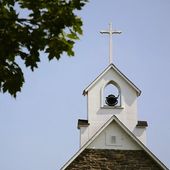Forty years ago this week, a rock festival at an upstate New York farm turned into one of the seminal events of the ’60s. Woodstock has since been celebrated in every corner of pop culture — music, movies, fashion and art, among them.
Now comes a celebration of Woodstock as a news event. A small exhibit at the Newseum, “Woodstock at 40: The Rise of Music Journalism,” explores how the concert event was covered by the news as an organizational disaster, concentrating on mud, traffic jams, food shortages and crowd control.
“Prior to Woodstock, there were few reporters in the mainstream media who covered rock music seriously,” says Newseum Executive Director Joe Urschel. “That changed very quickly after the festival. Many of the reporters who did attend completely missed the story, focusing instead on those things that seem insignificant now. It was the equivalent of going to cover the Super Bowl and neglecting to mention the football game.”
The Newseum exhibit features a five-minute film about Woodstock. The presentation, which runs on the 90-foot-long screen in the Robert H. and Clarice Smith Big Screen Theater, mixes news photographs, music and network footage of the concert with images taken by the exhibit’s featured photographers. Interviews with Barnard Collier, who covered the concert for the New York Times; Jan Hodenfield, who covered it for Rolling Stone; and USA Today rock critic Edna Gundersen are mixed with music from the concert.
Mr. Collier recounts in the film how he was at odds with his editors back in Manhattan, “who wanted a story about a catastrophe in the making.” In the end, Mr. Collier won approval to write the story the way he saw it.
Ms. Gundersen reflects on the infancy of rock journalism at the time of Woodstock. Rolling Stone magazine had only started publishing a year earlier.
That’s probably why the festival organizers let all sorts of people in to cover Woodstock. The bulk of the Newseum exhibit is from the collection of several photographers who were there: Dan Garson, a 17-year-old who asked organizers for a press pass so he could cover Woodstock for his Connecticut high school; Mark Goff, who covered Woodstock for a Milwaukee alternative weekly; and Henry Diltz, who was paid $500 by promoter Mike Lang to be the official Woodstock photographer.
It seems almost quaint now — in an era where star images are carefully controlled, paparazzi fight over the best shots and concerts are big, big business — that such access was granted.
The photographers made great use of that access. Mr. Garson, who died in 1992 at age 40, took more than 250 photos, but only four were published in the New Haven Register. The rest sat in a box in Mr. Garson’s parents’ basement. Some of the photos in the Newseum exhibit have never been seen before. Also on display: Mr. Garson’s camera, his notes, and the handwritten letter he received from organizers saying he had been approved for a press credential.
Meanwhile, Mr. Diltz’s photo story began by shooting concert preparations two weeks before the festival and continued through Jimi Hendrix’s Woodstock-ending performance. Mr. Diltz later sold his photos to Life magazine, which published them in a special edition.
Mr. Goff’s photos primarily were taken from the press pit, where he captured images of Joan Baez, Ravi Shankar, Roger Daltrey and Sly Stone, as well as the crowd. Also on display are his mud-splattered press kit, press pass and concert tickets.
Other parts of the display feature media coverage, including newspaper front pages from August 1969. One of the best was from the New York Daily News: “Hippies Mired in a Sea of Mud.”
The Newseum exhibit will run through Oct. 31. On Saturday, the actual anniversary of Woodstock, the Newseum will host several special events. Mr. Collier, who left the Times shortly after Woodstock, will give a talk about fact and fiction surrounding Woodstock.
Saturday is also Woodstock Kids Day. Children can tie-dye a bandana, make a love-bead bracelet or craft a protest button. The children’s activities run from 11 a.m. to 3 p.m. and are free with Newseum admission.
WHAT: “Woodstock at 40: The Rise of Music Journalism”
WHERE: Newseum, 555 Pennsylvania Ave. NW
WHEN: 9 a.m. to 5 p.m. daily through Oct. 31
ADMISSION: Adults $20; seniors, military and students $18; children ages 7 to 18 $13; children younger than 6 admitted free
PHONE: 888/639-7386
WEB SITE: www.newseum.org
• Karen Goldberg Goff can be reached at kgoff@washingtontimes.com.



Please read our comment policy before commenting.